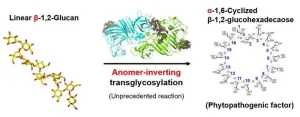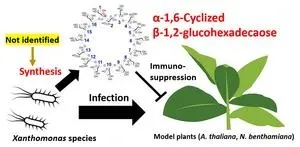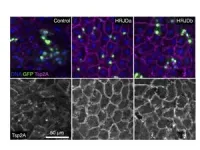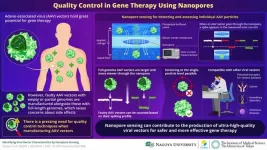(Press-News.org)
Plant diseases pose significant challenges to agricultural productivity, presenting formidable hurdles that require urgent attention. Left unchecked, these diseases can spread rapidly, inflicting widespread damage on crops and leading to reduced yields and substantial economic losses. Therefore, accurately identifying the pathogens responsible for these diseases is crucial. This identification allows for targeted interventions that minimize risks and effectively mitigate the agricultural impacts.
Xanthomonas species are notorious plant pathogens that affect a broad spectrum of hosts, including key crops like rice, wheat, and tomatoes. These pathogens augment their pathogenicity by utilizing α-1,6-cyclized β-1,2-glucohexadecaose (CβG16α) to suppress essential plant defense mechanisms, such as the expression of pathogenesis-related proteins and the accumulation of callose.
In a recent breakthrough published on June 19, 2024, in the Journal of the American Chemical Society, a team of researchers led by Associate Professor Masahiro Nakajima from Tokyo University of Science unveiled a significant discovery. They identified XccOpgD, a glycoside hydrolase (GH186) found in X. campestris pv campestris which plays a pivotal role in the biosynthesis of CβG16α. The research team also included Mr. Sei Motouchi from Tokyo University of Science, Principal Scientist Shiro Komba from the Institute of Food Research, NARO, and Hiroyuki Nakai from Niigata University.
“Glycan structures are intricate and multifaceted and fulfill diverse crucial roles in nature and organisms. Enzymes synthesize and degrade glycans, exhibiting diverse structures and functions that correspond to the glycan diversity. However, our understanding of these enzymes is still limited, which drives the search for new enzymes with varied new potentials,” explains Prof. Nakajima, elaborating on the study's rationale.
The team conducted biochemical analysis to elucidate the role of XccOpgD in CβG16α biosynthesis. Advanced techniques such as X-ray crystallography were employed as structural analysis to unravel the enzyme's catalytic mechanism and substrate specificity.
These efforts have yielded profound insights. XccOpgD belongs to the GH186 family, essential for regulating bacterial cell wall components. Unlike the first identified GH186 enzymes, XccOpgD exhibits an unprecedented enzymatic mechanism known as anomer-inverting transglycosylation.
“Reactions of typical GH enzymes are classified into four types by combination of retaining or inverting, and reaction with water (hydrolysis) or sugar (transglycosylation) theoretically. However, one classification is missing somehow in a long history of researches on carbohydrate associated enzymes and we discovered the missing classification. This breakthrough was made possible by unique structural environment, opening new possibilities for enzyme-based glycosylation,” explains Prof. Nakajima. Moreover, the sugar chains synthesized through this mechanism are not merely minor components but rather essential structures utilized by various Gram-negative bacteria in nature for pathogenic purposes.
Detailed studies revealed that linear β-1,2-glucan was converted to cyclic compound and the compound was identified as CβG16α using nuclear magnetic resonance. Structural analysis of the Michaelis complex identified crucial substrate binding residues, further elucidating specific interactions along the glucan chain. Notably, XccOpgD utilizes an anomer-inverting transglycosylation mechanism, with D379 and D291 playing pivotal roles as catalysts.
These findings deepen our understanding and open avenues for developing targeted strategies against Xanthomonas-induced plant diseases. “We are expecting a pesticide concept targeting this enzyme homolog in the future. Unlike fungicides that promote the emergence of drug-resistant bacteria in soil, targeting this enzyme could potentially inhibit pathogenicity without causing sterilization. Enzyme homologs identified in this study may serve as promising structure-based drug targets, offering a potential solution to the issue of drug-resistant bacteria,” says a hopeful Prof. Nakajima.
The discovery of XccOpgD and its role in CβG16α biosynthesis marks a major breakthrough in agriculture. It promises enhanced resilience and food security while mitigating environmental impacts linked to conventional pesticides. Overall, this advancement offers sustainable solutions to global agricultural challenges, promoting environmental stewardship and economic viability for farmers worldwide.
***
Reference
DOI: 10.1021/jacs.4c02579
Authors: Sei Motouchi1, Shiro Komba2, Hiroyuki Nakai3, and Masahiro Nakajima1
Affiliations:
1Department of Applied Biological Science, Tokyo University of Science
2Institute of Food Research, National Agriculture and Food Research Organization
3Faculty of Agriculture, Niigata University
Media contact
Yoshimasa Iwasaki
Public Relations Division
Tokyo University of Science
Email: mediaoffice@admin.tus.ac.jp
Website: https://www.tus.ac.jp/en/mediarelations/
Institute of Food Research
National Agriculture and Food Research Organization
Email: www@naro.affrc.go.jp
Public Relations office
Niigata University
Email: pr-office@adm.niigata-u.ac.jp
Funding information
This work was supported in part by JST SPRING (Grant 386 Number JPMJSP2151).
END
The development of human societies is concurrent with infrastructural changes, evidenced by rapid urbanization in recent years. We are moving towards the era of 'smart cities' powered by advanced technology—such as artificial intelligence (AI), the Internet of Things, and big data analytics—for sustainable urban development. However, climate change has been hampering this growth—earthquakes and other natural hazards negatively impact buildings and other structures in their wake.
Soil liquefaction is an example of a natural ...
Over the past few decades, there has been remarkable progress in genetic manipulation technologies, bringing us closer to the point where genes can be modified in vivo. Such tools would open up the way to gene therapy, ushering in a new era in medicine. Thus far, the most promising strategies for gene therapy involve leveraging the existing molecular machinery found in viruses.
In particular, adeno-associated virus (AAV) vectors have recently garnered significant attention from the scientific community, given their potential to serve as nucleic acid vaccines ...
When developing new drugs, understanding their effects on ion channels in the body, such as the human ether-a-go-go-related gene (hERG) ion channel found in neurons and heart muscle cells, is critical. Blocking hERG channels can disrupt normal heart rhythm, potentially leading to a fatal condition known as torsade de pointes. Current methods for assessing these effects typically involve invasive procedures like patch-clamp techniques or fluorescence microscopy. These methods alter cell properties and may affect measurement accuracy, requiring specialized equipment ...
Much of the water in the West is transported across vast geographical areas by large infrastructure projects known as interbasin water transfers. Two of these projects in particular make up 85% of all energy-related greenhouse gas emissions associated with U.S. interbasin transfers — one in Arizona and the other in California — according to the new research published this week in the journal Nature Water.
The project in Arizona is known as the Central Arizona Project and in California it’s the State Water Project.
“You hear a lot about these big projects and how much energy they use,” said Avery Driscoll, a doctoral student in ...
Higher levels of urinary metals such as cadmium, tungsten, uranium, cobalt, copper and zinc are linked to increased cardiovascular disease and mortality in a racially and ethnically diverse U.S. population, according to a new study at Columbia University Mailman School of Public Health. While it is well documented that exposure to certain metals has been associated with cardiovascular disease (CVD) and mortality, until now the evidence was limited beyond arsenic, cadmium, and lead and for a racially diverse population. The findings are published in the journal Circulation.
When analyzed together, ...
Human-made climate change can lead to a destabilisation of large-scale components of the Earth system such as ice sheets or ocean circulation patterns, the so-called tipping elements. While these components will not tip over night, fundamental processes are put into motion unfolding over tens, hundreds or thousands of years. These changes are of such a serious nature that they should be avoided at all costs, the researchers argue. In their new study, they assessed the risks of destabilisation of at least one ...
For some forms of tuberculosis, the chances that an exposed person will get infected depend on whether the individual and the bacteria share a hometown, according to a new study comparing how different strains move through mixed populations in cosmopolitan cities.
Results of the research, led by Harvard Medical School scientists and published Aug. 1 in Nature Microbiology, provide the first hard evidence of long-standing observations that have led scientists to suspect that pathogen, place, and human host ...
LA JOLLA, CA—To diagnose heart conditions including heart attacks and heart rhythm disturbances, clinicians typically rely on 12-lead electrocardiograms (ECGs)—complex arrangements of electrodes and wires placed around the chest and limbs to detect the heart’s electrical activity. But these ECGs require specialized equipment and expertise, and not all clinics have the capability to perform them.
Now, a team of scientists and clinicians from Scripps Research has shown that heart conditions can be diagnosed roughly as accurately using just three electrodes and an artificial intelligence (AI) tool. In a ...
Current climate policies imply a high risk for tipping of critical Earth system elements, even if temperatures return to below 1.5°C of global warming after a period of overshoot. A new study indicates that these risks can be minimized if warming is swiftly reversed.
Human-made climate change can lead to a destabilization of large-scale components of the Earth system such as ice sheets, ocean circulation patterns, or global biosphere components, the so-called tipping elements. In their new study published in Nature Communications, researchers from IIASA and the Potsdam Institute for Climate Impact Research (PIK) analyzed the risks for four interconnected core climate tipping elements ...
Vaccines are safe and effective, and help reduce death and illness. But global vaccination rates are suboptimal and have trended downward, leaving humanity more vulnerable to vaccine-preventable diseases such as COVID-19, influenza, measles, polio, and HPV.
Identifying interventions that could increase vaccine coverage could help save lives. A new paper from a team led by researchers at the University of Pennsylvania offers the first comprehensive meta-analysis examining what types of vaccine intervention strategies have the ...






